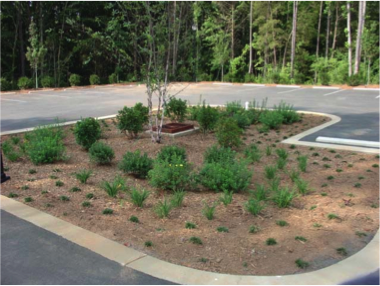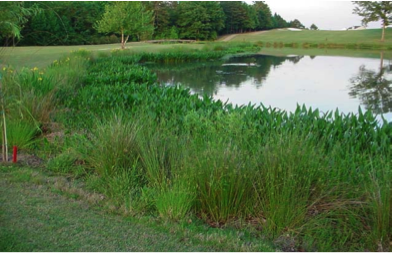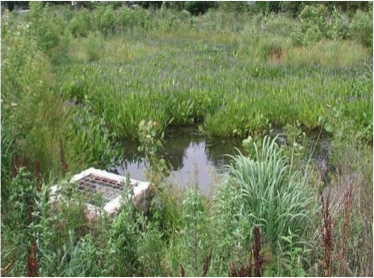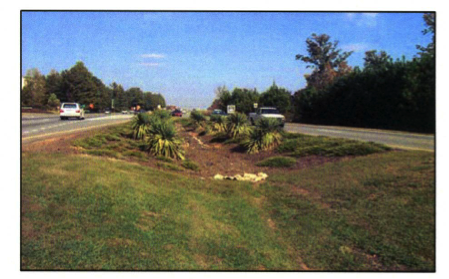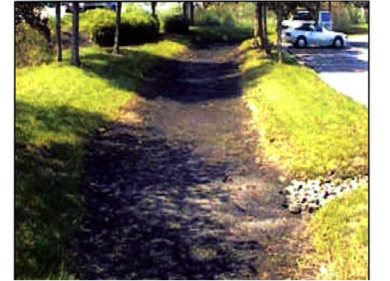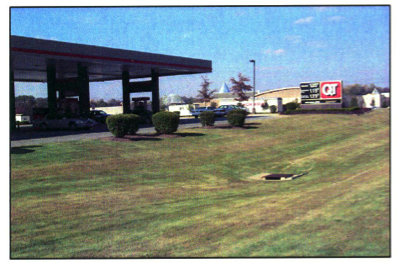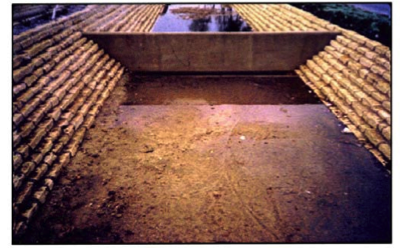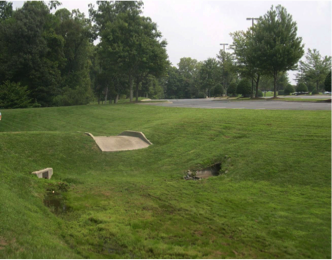BMP Overview
Stormwater BMPs, or Best Management Practices, are structural or non-structural devices used to alleviate the impacts of urban runoff on our aquatic resources. While the term “BMP” was first coined in the 1977 edition of the Clean Water Act, it wasn't until 1987 that it was written in as a stormwater management reference. Stormwater BMPs can come in many different forms, but all are designed to provide water quality/quantity mitigation from the effects of impervious surfaces and land development. Most can be used individually, but all are considered much more effective when used in conjunction with other BMPs, in a treatment train. The mitigation they provide may be accomplished in multiple ways including: infiltration, evapotranspiration, detention, filtration, biological, and chemical means, depending on the BMP utilized and the features of the drainage area in which they are constructed. The following BMP’s are a few of the main devices that are installed in the Charlotte region:
-
Bioretention
Bioretention
Shallow storm water basin or landscaped area that utilizes engineered soils and vegetation to capture and treat runoff. Bioretention facilities are intended to provide water quality functions by filtering stormwater runoff and allowing vegetation uptake of nutrients. Treatment area consists of grass filter, sand bed, ponding area, organic/mulch or sod layer, planting soil, and vegetation. The primary processes that this BMP uses for pollutant removal are filtration and biological uptake.For more information please click on the following link: http://charmeck.org/stormwater/regulations/Documents/BMP%20DSM/4.1%20Bioretention-July%201,%202013.pdf
-
Wet Pond
Wet Pond
Constructed storm water wet ponds have a permanent pool, a temporary pool and typically a littoral shelf with planted vegetation. Runoff from each rain event is detained and pollutants are treated in the pond. Temporary storage (live storage) is provided above the permanent pool elevation and is released at a controlled rate. Pollutant removal is primarily accomplished through sedimentation and biological processing.For more information please click on the following link: http://charmeck.org/stormwater/regulations/Documents/BMP%20DSM/4.2%20Wet%20Pond-July%201%202013.pdf
-
Stormwater Wetland
Stormwater Wetland
Constructed storm water wetlands temporarily store runoff in relatively shallow pools that support conditions suitable for the growth of wetland plants. Storm water wetlands are wetland systems designed to maximize the removal of pollutants from storm water runoff through settling and both uptake and filtering by vegetation. Wetlands typically consist of four zones: shallow land (temporary storage), shallow water, open water (forebay and micro-pool), and upland areas. The runoff volume is both stored and treated in the storm water wetland permanent pool and temporary storage volume above the surface of the marsh.For more information please click on the following link: http://charmeck.org/stormwater/regulations/Documents/BMP%20DSM/4.3%20Treatment%20Wetlands-July%201%202013.pdf
-
Enhanced Grass Swale
Enhanced Grass Swale
Enhanced grassed swales (also called vegetated open channels, water quality swales or engineered swales) are vegetated open channels that are explicitly designed and constructed to capture and treat storm water runoff by limiting the slope in the direction of flow or within dry cells formed by check dams or other means. Swale pollution removal effectiveness is provided by sedimentation, biologic activity, and infiltration. Swales can also be designed without check dams or engineered media as grass channels but with greatly reduced pollution removal rates.For more information please click on the following link: http://charmeck.org/stormwater/regulations/Documents/BMP%20DSM/4.4%20%20Enhanced%20Grassed%20Swale-July%201,%202013.pdf
-
Infiltration Trench
Infiltration Trench
Infiltration trenches are excavated trenches filled with stone aggregate used to capture and allow exfiltration of storm water runoff into the surrounding soils from the bottom and sides of the trench. Infiltration trenches are used to remove pollutants and to infiltrate storm water back into the ground. The infiltration also helps to reduce increases in both the peak rate and total volume of runoff caused by land development. Pollutant removal is achieved through filtration of the runoff through the stone aggregate and soil as well as biological and chemical activity within the soil.For more information please click on the following link: http://charmeck.org/stormwater/regulations/Documents/BMP%20DSM/4.6%20Infiltration%20Trench-July%201,%202013.pdf
-
Filter Strip
Filter Strip
Filter strips are uniformly graded and densely vegetated sections of land engineered and designed to treat runoff from and remove pollutants through vegetative filtering and infiltration. Wooded buffer strips are natural areas adjacent to streams that are maintained to perform similarly to filter strips. Pollution removal is provided by sedimentation, filtration, adsorption, infiltration, biological uptake, and microbacterial activity. Some infiltration may occur depending on the characteristics of the soils. Filter strips can be designed with and without permeable berms.For more information please click on the following link: http://charmeck.org/stormwater/regulations/Documents/BMP%20DSM/4.7%20Filter%20Strip-July%201,%202013.pdf
-
Sand Filter
Sand Filter
Multi-chamber structure designed to treat storm water runoff through filtration, using a sediment forebay, a sand bed as its primary filter media and, typically, an underdrain collection system. It can be configured as either a surface or subsurface facility. In sand filter systems, storm water pollutants are removed primarily through filtration with some additional treatment from gravitational settling and adsorption.For more information please click on the following link: http://charmeck.org/stormwater/regulations/Documents/BMP%20DSM/4.8%20%20Sand%20Filters-July%201%202013.pdf
-
Extended Dry Detention
Extended Dry Detention
A storage facility designed to provide water quantity control and some water quality control through detention and/or extended detention of storm water runoff. It has an outlet structure that detains and attenuates runoff inflows and promotes the settlement of pollutants. Facility normally remains dry between storm events. A subsurface extended detention basin is located entirely below the ground surface in a vault, pipe, or stone bed.For more information please click on the following link: http://charmeck.org/stormwater/regulations/Documents/BMP%20DSM/4.9%20Extended%20Dry%20Detention-July%201,%202013.pdf
-
Planting Considerations
-
Planting List
-
Erosion Control Overview
Erosion Control Overview
Erosion and sedimentation control measures are devices used during the construction of any residential or commercial development that prevent erosion from occurring and/or sediment from being discharged from the development and/or into adjacent watercourses. Watercourses can mean lakes, ponds, wetlands, streams, rivers, etc. The practice of controlling erosion has been around for thousands of years, primarily as a practice used to conserve land for agriculture, but modern practices and standards weren't developed until the 20th century. Today, using mathematics and soil science, techniques for preventing water pollution associated with erosion and sedimentation have become widespread and standardized, even as the technology continues to press forward and improve on reducing suspended particle concentrations and applicability. The main concepts behind today’s technology rely, first, on preventing the erosion from occurring, using cover or stabilization, and second, on capturing and holding sediment laden water long enough for gravity to settle soil particles out.
-
Erosion Control Overview
Erosion Control Overview
Erosion and sedimentation control measures are devices used during the construction of any residential or commercial development that prevent erosion from occurring and/or sediment from being discharged from the development and/or into adjacent watercourses. Watercourses can mean lakes, ponds, wetlands, streams, rivers, etc. The practice of controlling erosion has been around for thousands of years, primarily as a practice used to conserve land for agriculture, but modern practices and standards weren't developed until the 20th century. Today, using mathematics and soil science, techniques for preventing water pollution associated with erosion and sedimentation have become widespread and standardized, even as the technology continues to press forward and improve on reducing suspended particle concentrations and applicability. The main concepts behind today’s technology rely, first, on preventing the erosion from occurring, using cover or stabilization, and second, on capturing and holding sediment laden water long enough for gravity to settle soil particles out.

